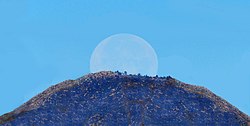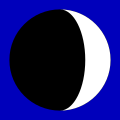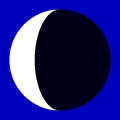Phases of the Moon

The phases of the Moon are the different ways the Moon looks from Earth.
As the Moon orbits around the Earth, the half of the Moon that faces the Sun will be lit up. The different shapes of the lit portion of the Moon that can be seen from Earth are known as phases of the Moon. Each phase repeats itself every 29.5 days.
The same half of the Moon always faces the Earth, because of tidal locking. So the phases will always occur over the same half of the Moon's surface.
Phases
A phase is an angle of the Moon to the Earth so it appears differently every day. The Moon goes through eight main phases.
- A new moon is when the moon cannot be seen because we are looking at the unlit half of the Moon. The new moon phase occurs when the Moon is directly between the Earth and Sun. A solar eclipse can only happen with a new moon.
- A waxing crescent moon is when the Moon looks like a crescent and the crescent grows (or "waxes") in size from one day to the next. This phase is usually only seen in the west.
- The first quarter moon (or a half moon) is when half of the lit portion of the Moon can be seen after the waxing crescent phase. It comes a week after a new moon.
- A waxing gibbous moon occurs when more than half of the lit portion of the Moon can be seen and the shape grows (or "waxes") in size from one day to the next. The waxing gibbous phase occurs between the first quarter and full moon phases.
- A full moon is when we can see the entire lit portion of the Moon. The full moon phase occurs when the Moon is on the opposite side of the Earth from the Sun, called opposition. A lunar eclipse can only happen with a full moon.
- A waning gibbous moon occurs when more than half of the lit portion of the Moon can be seen and the shape shrinks (or "wanes") in size from one day to the next. The waning gibbous phase occurs between the full moon and third quarter phases.
- The last quarter moon (or a half moon) is when half of the lit portion of the Moon is visible after the waning gibbous phase.
- A waning crescent moon is when the Moon looks like a crescent and the crescent shrinks (or "wanes") in size from one day to the next.
"Blue moon''
Phases Of The Moon Media
The lunar phases and librations in 2025 as viewed from the Northern Hemisphere at hourly intervals, with titles and supplemental graphics
The lunar phases and librations in 2025 as viewed from the Southern Hemisphere at hourly intervals, with titles and supplemental graphics
A full moon sets behind San Gorgonio Mountain in California on a midsummer's morning.
The phases of the Moon as viewed looking southward from the Northern Hemisphere. Each phase would be rotated 180° if seen looking northward from the Southern Hemisphere. The upper part of the diagram is not to scale, as the Moon, the Earth, and the Moon's orbit are all much smaller relative to the Earth's orbit than shown here.
This video provides an illustration of how the Moon passes through its phases – a product of its orbit, which allows different parts of its surface to be illuminated by the Sun over the course of a month. The camera is locked to the Moon as Earth rapidly rotates in the foreground.
The lunar phase depends on the Moon's position in orbit around the Earth and the Earth's position in orbit around the Sun. This animation (not to scale) looks down on Earth from the north pole of the ecliptic.
Related pages
References
- ↑ However, a blue moon can also refer to the third full moon in a season with four full moons.
- ↑ Sinnott, Roger W., Donald W. Olson, and Richard Tresch Fienberg (May 1999). "What's a Blue Moon?". Sky & Telescope. Archived from the original on March 22, 2008. Retrieved February 9, 2008.
The trendy definition of "blue Moon" as the second full Moon in a month is a mistake.





